![]()
![]()
![]()
Use LEFT and RIGHT arrow keys to navigate between flashcards;
Use UP and DOWN arrow keys to flip the card;
H to show hint;
A reads text to speech;
100 Cards in this Set
- Front
- Back
|
Describe how scientists view Earth today.
|
Earth System Science is the study of Earth materials and processes subdivided into group of four interconnected spheres of activity: atmosphere, geosphere, hydrosphere and biosphere.
|
|
|
Compare and contrast open and closed systems.
|
A open system is a system in which there is a free exchange of both energy and matter between the system and it's surroundings. A closed system is a system in which energy can enter or leave, but matter cannot.
|
|
|
Explain the significance of Earth as an essentially closed system.
|
Earth receives radiant energy from the sun and reflects much of it back into space (an exchange of energy). The system is not entirely closed, however. The atmosphere loses hydrogen atoms to space and meteorites enter the atmosphere from space.
|
|
|
Describe the four spheres of the Earth system.
|
The atmosphere is composed of a mixture of gases and provides living things with oxygen and carbon dioxide. The geosphere is the rocks, the mountains, the beaches and all other physical features of the planet except for water. The hydrosphere contains all the water in the Earth system, including water in oceans, lakes and rivers, and groundwater. The biosphere includes all forms of life, from single-celled protozoans to jellyfish to redwood trees to people.
|
|
|
Explain how the spheres interact and change.
|
Volcanoes (geosphere) erupt, sending ash and gases into the air (atmosphere) and lava and ash down onto surrounding forests (biosphere) and human habitations (biosphere). An interaction can take one of many forms. It can be a single event, such as an eruption of a volcano or a flood. It can be a temporary change, such as a cold snap that kills a fruit crop. Or it can be a ongoing, steady process, such as erosion.
|
|
|
Describe the characteristics of water, carbon and energy cycles.
|
Most of Earth's water is in liquid form. in the oceans. All of the water, either fresh or salt, has moved through the water cycle millions of times. Water is never created or destroyed- only changed. Carbon, also called the building-block of life, is present in all organic material and in materials, such as coal and oil, that are derived from once-living things. The movement of energy into and out of the Earth system is called the energy cycle.
|
|
|
Analyze how humans interact with water, carbon and energy cycles.
|
Water is our most precious resource and is vital to life. Humans, plants, and animals are made up of mostly water. We use water for drinking, washing, cleaning, cooking, and growing our food as well as many, many other things. Humans don't really use carbon dioxide other than when we breath in oxygen, we breath out carbon dioxide.
|
|
|
What is the only thing that can leave in a closed system?
|
In a closed system, energy can enter and leave, but matter cannot leave.
|
|
|
Where is most of Earth's water found?
|
Most of Earth's water is found in oceans.
|
|
|
Contrast the cycles presented in Chapter 1.
|
The water cycles is the continuous circulation of water through the hydrosphere. The carbon cycle is a biogeochemical cycle involving the element carbon. The energy cycle is the movement of energy into and out of the Earth system.
|
|
|
What is Earth's major source of energy?
|
The sun is Earth's major source of energy.
|
|
|
Why is phytoplankton critical to the carbon cycle?
|
The carbon dioxide in the atmosphere is in balance with carbon dioxide in the ocean. During photosynthesis, phytoplankton remove carbon dioxide from sea water and release oxygen as a by-product. This allows the oceans to absorb additional carbon dioxide from the atmosphere. If fewer phytoplankton existed, atmospheric carbon dioxide would increase.
|
|
|
List an example of both of the cycles.
|
An example of the water cycle is evapotranspiration, which is the cycling of water vapor into the atmosphere by evaporation and transpiration.
|
|
|
How would you describe an object, process, or phenomenon?
|
An object is a material thing that can be seen or touched. A process is a series of steps taken to achieve an end. A phenomenon is a fact or situation that is observed to exist or happen.
|
|
|
Identify possible differences and similarities among scientists that study Earth.
|
Some scientists work in laboratories and some work in the field. Some wear lab coats and some wear jeans. Some teach while others focus on research. Scientists all share what is best described as "the scientist's mind" which is a way of looking at the world with both logic and a sense of wonder.
|
|
|
Describe the qualities of scientific thinking.
|
Scientists are always asking questions, investigating questions, observant, creative, and skeptical.
|
|
|
Explain the importance of scientific inquiry and peer review.
|
Scientific inquiry involves observing, asking asking question, forming a hypothesis, gathering data, testing the hypothesis and sharing what has been learned. Peer review is when the scientist's knowledge is reviewed and tested by other scientists.
|
|
|
Explain the difference between a hypothesis, a theory, and a law.
|
A hypothesis is a tentative explanation for an observation or phenomenon. A theory is an explanation for observable events or facts for which no exception has been found. A law is a generalization about how the natural world behaves under certain conditions. Theories grow from laws, but they do not become laws after further testing.
|
|
|
Describe simple and complex tools that Earth scientists use.
|
Scientists use simple rock hammers, a crusher or pulverizer, hand lens, earth drills, laser range finders, seismographs, dredges, gravity corers, thermometer, aerovanes, radar or satellite pictures, telescopes, telescopes, computers, and satellites.
|
|
|
Explain how computers and satellites have advanced Earth science.
|
With computers, earth scientists can now analyze larger amounts of data than ever before, in a fraction of time it took in the past. Satellites create images that scientists can study to view weather patterns and rock types.
|
|
|
What is the goal of science?
|
The goal of science is to explain the natural world as we observe it and to search for ways of applying such knowledge for the better of humanity.
|
|
|
What is a theory?
|
A theory is an explanation or model based on observation, reasoning, and experimentation, especially one that has been tested and confirmed as a general explanation for phenomena that has been observed.
|
|
|
Who was Carl Segan and what field of science was he involved in?
|
Carl Segan was a noted astronomer and popularizer of science through books and television shows.
|
|
|
Contrast a theory and a law.
|
A theory is an explanation for observable events or facts for which no exception has been found. A law is a generalization about how the natural world behaves under certain conditions
|
|
|
Explain how maps are models of Earth.
|
A map is a two-dimensional representation of Earth's surface. But because it is two dimensional, a map cannot depict the three-dimensional Earth as accurately as a globe can.
|
|
|
Compare and contrast three types of map projections.
|
The Mercator Projection depicts the Earth as if a large cylinder of paper had been wrapped around the planet, and the outlines of the continents had been projected onto the paper. The Gnomic Projection is made as if a sheet of paper had been laid on a point on Earth's surface, often one of the poles. The Polyconic Projection is made as if a cone of paper had been wrapped around Earth.
|
|
|
Use latitude and longitude to describe a location on Earth.
|
Saint Francis High School, Mountain View, California- Latitude: 37-22'08'' N; Longitude: 122-05'07'' W
|
|
|
Relate the history of mapmaking.
|
Cartographers used to carry a table and climb to the area's highest vantage point and draw a map of whatever features he could see. However, the long-standing methods of mapmaking changed tremendously when it became possible to take photographs from airplanes.
|
|
|
Describe the roles of satellites and computers in making and using maps.
|
As the satellite orbits Earth, a scanner constantly records data from Earth's surface. Instruments measure invisible electromagnetic waves, emitted by each object on Earth. Because these waves are unique for every object, computers can analyze and identify them. The data collected are converted to code, then to pixels-- electronic dots. Computer software then converts the pixels into usable images.
|
|
|
Explain how topographic maps use contour lines to show elevation.
|
Contour lines are drawn to connect points of the same elevation in an area. The first line shows 0 feet below sea level. The next will show 10 feet above sea level and so on.`
|
|
|
Describe topographic map symbols.
|
Contour lines can form circles or ovals. They indicate hills, ridges, or mountains. Bodies of water are indicated as blue. Human-made features are depicted in black on topographic maps.
|
|
|
Demonstrate how to use topographic maps to determine the shape of the land, the flow of rivers, and distance.
|
You can draw a line across the map. Wherever the line meets a contour, the exact height above sea level is known.
|
|
|
Why is it necessary to make different models of Earth?
|
Two-dimensional models do not compare to three-dimensional models. For instance, if we could choose, we would much rather use a globe than a mercator projection. This is because the globe is a three-dimensional representation of our three-dimensional planet.
|
|
|
What is the prime meridian?
|
The Earth's 0 of longitude.
|
|
|
What would you notice if you were looking at a map drawn with a Mercator projection?
|
You would notice that the areas near the poles were distorted.
|
|
|
Explain how most scientists explain the formation of our solar system.
|
About 4.6 billion years ago, a great cloud of gas and dust was rotating slowly in space. The cloud was at least 10 billion kilometers in diameter. As time passed, the cloud shrank under the pull of its own gravity. As it shrank, its rate of rotation increased. Most of the material in the rotating cloud gathered around its center. At this time, the star we now call our sun was born. The planets continued to compress and spin, sometimes colliding with each other and other objects in space. Eventually, these objects formed planets and moons.
|
|
|
Describe Earth's size and shape and the arrangement of its layers.
|
Earth is not a perfect sphere. The total surface area is about 510 million square kilometers. Earth's interior is arranged by the inner core (innermost layer), the outer core (just outside the inner core), the mantle (above the core) and the crust (the outermost layer).
|
|
|
List three sources of Earth's internal heat.
|
Some heat has come from the meteorite impacts, the weight of overlying materials causes compression in Earth's interior, and by the decay of isotopes.
|
|
|
Describe the Earth's magnetic field.
|
The Earth's magnetic field is almost like a bar magnet lying inside Earth with each end pointing toward one of Earth's poles. The ends of the magnet are tilted about 11º away from the poles. Earth's magnetic field is the resulting lines of force that loop from one end of the bar magnet to the other.
|
|
|
Give evidence of Earth's rotation.
|
A pendulum, a device that once set in motion, the direction of the swing would not change. However, they discovered that every hour the direction of the swing would change 11º.
|
|
|
Relate Earth's rotation to the day-night cycle and the time zones.
|
Because of Earth's rotation, solar noon does not occur at the same time everywhere. It moves westward at a rate of about 15º each hour.
|
|
|
Give evidence for Earth's revolution around the sun.
|
As Earth moves in its orbit, nearby stars appear to shift position when compared to distant stars. This shift is called a parallax.
|
|
|
Describe Earth's path and rate of revolution.
|
The direction of Earth's revolution is the same as its direction of rotation, that is, counterclockwise when viewed from above the North Pole. Earth makes one revolution every 365 days.
|
|
|
Explain why seasons occur.
|
Seasons occur because of the tilt in Earth's axis. Days are longer in the summer and shorter in the winter. The angle of the Sun's rays hitting the planet creates the seasons. However, it has nothing to do with the distance from the Sun.
|
|
|
In which of Earth's layers would you most likely find iron, magnesium and silicon?
|
You would find iron, magnesium and silicon in the mantle.
|
|
|
Draw a picture of all of Earth's layers.
|
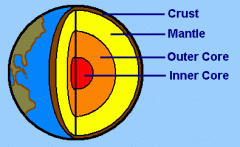
|
|
|
Name 3 Silicates.
|
Quartz, Feldspar, and Mica
|
|
|
Identify the characteristics of matter.
|
Matter exists in several different states: solids, liquids and gases. Each state of matter has unique physical properties.Gases are easily compressed but liquids and solids do not compress easily. Solids have their own particular shapes, but liquids and gases take the shape of the container.
|
|
|
Describe three types of chemical bonds.
|
Covalent bonds are formed when atoms share electrons. Ionic bonds are held together by the force of electrical attraction between atoms that have lost or gained electrons. Metallic bonds form between metal atoms and nonmetal atoms.
|
|
|
Identify the characteristics of minerals.
|
1) It occurs naturally.
2) It is solid 3) It has a definite chemical composition 4) Its atoms are arranged in an orderly pattern. 5) It is inorganic (never was alive) |
|
|
Explain how minerals form.
|
Minerals can form through the magma process and the pressure process. The magma process is when the magma rises from deep within Earth. The particles in the hot magma move freely. When the magma begins to cool, atoms, molecules and ions move closer together and bond to form various compounds. Over time, molecules of the compounds mass together as grains of minerals. The pressure process is when a rock is subjected to high temperature and pressure, the minerals can begin to break down chemically. The temperature and pressure becomes great enough to change the minerals in a solid state, without melting them. The free atoms, ions, and molecules recombine in new ways, forming new minerals. More growth occurs in directions away from the pressure.
|
|
|
List the physical characteristics of minerals that are influenced by their crystalline structure.
|
Crystal structure will determine a mineral's cleavage, or tendency to split along definite planes. Also at high temperatures, minerals melt, becoming liquids made up of loose groups of particles.
|
|
|
Identify rock forming minerals by inspection, using physical properties such as color, luster, and crystal shape.
|
Luster is the way the mineral shines in light. Luster can be described as either metallic or nonmetallic. Streak is the color of its powder. Streak can be obtained by rubbing the mineral on an unglazed white tile, called a streak plate.
|
|
|
Describe the properties of the most common minerals, silicates, and carbonates.
|
Most silicates contain more metallic elements such as iron. Most carbonates are made of negatively charged carbonate ions bonded to positive metal ions.
|
|
|
Describe tests used to identify mineral groups.
|
Some tests that might be run are the hardness test based on the Mohs Scale of relative mineral hardness, specific gravity, streak test for mineral color, classification of mineral crystal system, chemical analysis.
|
|
|
Name the specific features that you would use to describe a rock.
|
Color, streak, fracture, hardness, and crystal shape.
|
|
|
Differentiate among the three major types of rock.
|
Igneous rocks are formed by the cooling and hardening of hot, molten rock, or magma, from inside Earth. Sedimentary rocks are formed by the compaction and cementing of layers of sediments. Sediments are materials such as rock fragments, plant and animal remains, and minerals that settle out of solution onto lake and ocean boundaries. Metamorphic rocks are formed by the effect of heat and pressure on other rocks.
|
|
|
Distinguish between intrusive and extrusive rocks and how they form.
|
Magma trapped deep in Earth's crust hardens very slowly to form intrusive igneous rocks. When magma pours onto Earth's surface during a volcanic eruption and cools, an extrusive igneous rock forms.
|
|
|
Contrast the types of plutons that form as the result of intrusive igneous activity.
|
In general, an igneous intrusion- a rock mass that forms when magma cools inside Earth's interior- may be called a pluton.
|
|
|
Distinguish among the three types of sedimentary rocks and how they form.
|
Clastic sedimentary rocks form from fragments of other rocks. Chemical rock forms from dissolved minerals from the water in seas, lakes and underground reservoirs. Organic rock forms from the sediments consisting of the remains of plants and animals.
|
|
|
Explain the processes involved in the formation of metamorphic rock.
|
The process by which a rock's structure is changed by pressure, heat, and moisture is called metamorphism. Regional metamorphism can occur during mountain-building movements of the crust, when large areas of rock change form after exposure to intense heat and pressure. Local metamorphism occurs when hot magma moves into rock, heating and changing it.
|
|
|
Give a few examples of igneous rock.
|
Some examples of igneous rocks are granite, rhyolite, and
obsidian. |
|
|
Distinguish between renewable and nonrenewable resources.
|
A renewable resource is one that can be replaced in nature at a rate close to its rate of use. A nonrenewable resource exists in a fixed amount or is used up faster than it can be replaced in nature.
|
|
|
Identify renewable and nonrenewable resources.
|
Renewable resources include air, water, crops, forests, sunlight, soil, and ice. Nonrenewable resources include coal, petroleum, natural gas, sand, gravel, building stone, crushed stone, salt, talc, graphite, sulfur, gypsum, uranium, and phosphate rock.
|
|
|
Explain how fossil fuels form.
|
Fossil fuels are formed from the remains of organisms that lived millions of years ago.
|
|
|
Describe how the use of nonrenewable resources affects the environment.
|
We burn coal, oil and natural gas to produce electricity and drive our transport. Burning fossil fuels releases carbon dioxide which adds to the other greenhouse gases in the atmosphere. Greenhouse gases contribute to the warming of the earth.
|
|
|
What is a mineral reserve?
|
A mineral reserve is the known deposits of a mineral in ores that are worth mining.
|
|
|
What is the most common source of fossil fuels?
|
Coal is the most common source of fossil fuels.
|
|
|
Where does most electricity in the U.S. come from?
|
Most electricity in the U.S. comes from power plants.
|
|
|
What is gasoline refined from?
|
Gasoline is refined from petroleum.
|
|
|
Discuss some evidence that Alfred Wegener used to support his idea of continental drift.
|
He noted that the fossil remains of Mesosaurus, a reptile that lived about 270 millions years ago, are found only in parts of South America and Africa. Distinctive rock formations found on both continents would have matched up with each other if the continents had been joined in the past. Climate change evidence further supports the theory of continental drift.
|
|
|
Explain how plate tectonics help to predict the location of earthquakes and volcanoes.
|
The theory of plate tectonics helps explain the pattern of earthquakes and volcanoes because the belts mark the locations of plate boundaries.
|
|
|
Discuss the differences among the three types of plate boundaries.
|
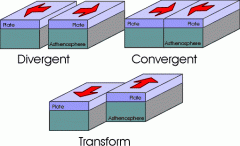
A divergent boundary is a boundary between two lithospheric plates that are moving apart. A convergent boundary is a boundary between two plates that are moving towards each other, or converging. A transform boundary is a boundary between two plates that are sliding past each other
|
|
|
Discuss mantle convection as a possible cause of plate movement.
|
Heat from Earth's inner and outer cores is transferred through the mantle by a process called mantle convection. According to the mantle convection hypothesis, the mantle may be moving the plates along with it as it convects.
|
|
|
Compare and contrast ridge push and slab pull.
|
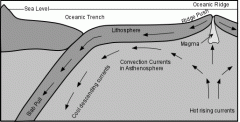
Ridge push is a force that is exerted by cooling, subsiding rock on the spreading lithospheric plates at mid-ocean ridge. Slab pull is a force at a subduction boundary that the sinking edge of the subducting plate exerts on the rest of the plate.
|
|
|
Explain how landmasses have changed over the past 200 million years.
|
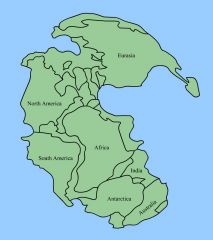
Evidence indicates that around 250 million years ago, all the continents were welded together into one landmass.
|
|
|
Describe the Lithosphere.
|
The lithosphere is the outer shell of the Earth consisting of the crust and uppermost portion of the mantle.
|
|
|
Analyze how magma forms as the result of plate motion and interaction.
|
Conditions at both divergent and subduction boundaries are ideal for magma formation. Most volcanoes are found along mid-ocean ridges, where plates are moving apart, and at subduction boundaries, where plates are being forced under other plates.
|
|
|
Explain why plate boundaries are the sites of most volcanic activity.
|
Most volcanoes form at hotspots, which are areas of volcanic activity that result from plumes of hot solid material that have risen from deep within Earth's mantle, which are located on plate boundaries.
|
|
|
Identify the three types of magma and locate where each one forms.
|
Basaltic, Andesitic, and Rhyolitic are the three types of magma. Basaltic magma forms at rifts and oceanic hot spots. Andesitic magma forms at subduction boundaries. Rhyolitic magma forms at continental hot spots.
|
|
|
Compare characteristics of magma and lava.
|
Lava is just magma that reaches the surface.
|
|
|
Describe plyoclastic materials.
|
Pyroclastic materials are solid fragments that are ejected in a volcanic eruption.
|
|
|
How does silica affect the flow of magma?
|
Low silica magma, called basaltic, is fluid and produces a quiet non-explosive eruption. High silica magma, called granitic and andestic, produce an explosive eruption.
|
|
|
What conditions affect the formation of magma?
|
A decrease in pressure can lower the melting temperatures of materials in the asthenosphere. Such a decrease takes place along the rift valley at mid-ocean ridge. An increase in temperature can cause materials in the asthenosphere to melt. Such an increase occurs at a hot spot. An increase in the amount of water in the asthenosphere can lower the melting temperatures of materials there. Such an increase occurs at subduction boundaries.
|
|
|
Explain how most earthquakes result from strain that builds up along faults or near plate boundaries.
|
An earthquake is a shaking of Earth's crust caused by a release of energy. Most of the time, friction prevents the plates from moving, so strain builds up causing the plates to deform, or change shape.
|
|
|
Describe how the energy release in an earthquake travels as waves.
|
The energy released in an earthquake travels in waves. Waves that travel from the focus of an earthquake through the Earth are called body waves because they travel through the material of Earth's body. The body waves known as compressional waves, primary waves or P waves squeeze and stretch rock materials as they pass through Earth. The body waves called shear waves, secondary waves, or S waves cause particles of rock material to move at right angles to the direction in which the waves are traveling.
|
|
|
Explain how a seismograph is used to record earthquake waves and locate an earthquake's epicenter.
|
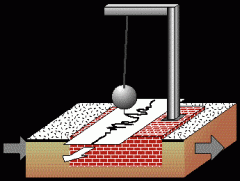
|
|
|
Summarize how the magnitude of an earthquake is measured.
|
The magnitude of an earthquake is a measure of the amount of energy released. You can measure the magnitude of an earthquake using the Richter scale.
|
|
|
How many seismograph locations do you need to locate an epicenter?
|
3
|
|
|
Describe how data from seismic waves are used to infer the structure of the Earth's interior.
|
Seismologists have observed that the velocities of both P waves and S waves increase when the waves travel through more dense material, and decrease when the waves travel through material that is less dense.
|
|
|
What is the difference between P waves and S waves?
|

P-waves are faster than s-waves. Both can pass through solid rock, but only p-waves can pass through gases and liquids
|
|
|
What is the difference between a focus and an epicenter?
|
A focus is the point at which the first movement occurs during an earthquake. An epicenter is the point on Earth's surface directly above the focus of an earthquake.
|
|
|
Explain how some of Earth's major mountain belts are formed.
|
Most of the world's mountains occur in long belts that tend to follow convergent plate boundaries. These mountain belts are regions where mountains are forming or have formed in the past.
|
|
|
Compare and contrast active and passive continental margins.
|
Both passive and active continental margins are located near coastlines. The main difference is that active margins are the main sites where tectonic activity takes place (like earthquakes). This is because the continental shelf of active continental margins collide with an oceanic plate, creating subduction. Very little tectonic activity takes place in passive continental margins because there's no subduction and collision. That's why passive continental margins are usually characterized as flat land and wide continental shelves.
|
|
|
Compare and contrast anticlines and synclines.
|
Anticlines and synclines are folded rock layers. Anticlines are folds in which the oldest rock lies in the center or core and synclines have the youngest rock in its center or core.
|
|
|
Distinguish among three types of faults.
|
A normal fault occurs when the hanging wall moves down with respect to the footwall. A reverse fault occurs when the hanging wall moves up with respect to the footwall. A strike-slip fault, the rocks on opposite sides of the fault plane move horizontally past each other.
|
|
|
What type of fault do we live on?
|
A strike-slip fault
|
|
|
Compare and contrast folded mountains, dome mountains, and fault-block mountains.
|
Folded mountains occur when two plates carrying continental crust collide, rocks can fold and crumble. A dome mountain is a nearly circular folded mountain. Fault-block mountains formed by tension.
|
|
|
Contrast the different types of stress on rock.
|
Compression causes the rock layers are being squeezed inward. Stress that involves squeezing is called compression. Compression tends to make rock layers thicker and shorter. Tension causes the rock layers to be stretched. Stress that involves pulling and stretching is called tension. Some of the layers may have fractures.Shear stress causes the rock layers to be pushed in two different, opposite directions. Stress that involves forces moving in opposite directions is called shear stress. Shear stress tends to distort the shape of the rocks, especially along the plane between the opposing forces.
|
|
|
What causes valley and ridge locations?
|
Anticlines cause ridges and synclines cause valleys.
|

